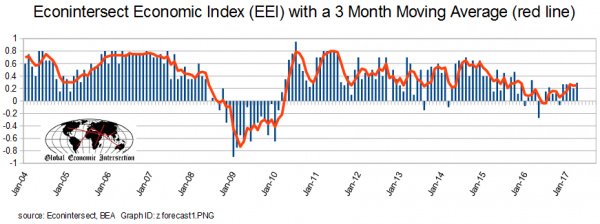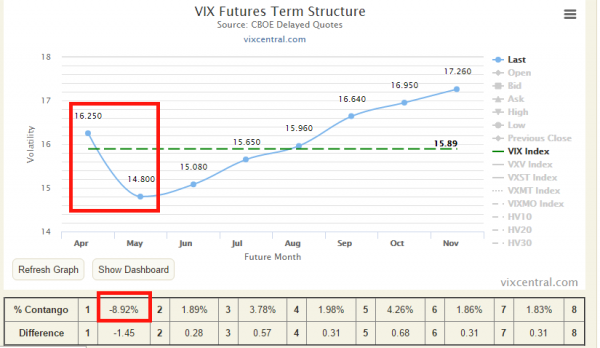Easter has arrived, and with it, a four-day holiday weekend in many parts of the world that gives investors, analysts, and the public at large time to pause, reflect, and become optimistic about the road ahead. After all, it is springtime. Flowers are blooming. Leaves are bursting out all over, as the Sun ignites the Earth’s annual re-birthing process across the Northern Hemisphere of the planet. It is normally a time for healthy enthusiasm, but our financial markets are not buying into the notion. Geopolitical tensions are also sprouting up across the globe, causing a spike in volatility futures, and basically raining on our Easter parade. Can our global economy withstand another shock?
It is a sign of the times that anyone benefiting from this market’s upward thrust is also looking for any early warning indication that the time to exit stage left is imminent. The current Bull market is breaking records right and left, but when is enough going to be enough? The global economy seems to be mired in a low GDP growth gear, a product of the recent financial crisis and the interdependence of globalization machinations. The consensus at this stage presumes that the U.S. economy will jumpstart the world back into a higher growth gear, but, for now, there has been a wealth of political rhetoric, but little in the way of material follow through.
Analysts continue to search for the “Holy Grail”, i.e., the one and only perfect chart that will confirm to all when and what will happen next in our financial milieu. Billions of potential gains or losses hang in the balance. The fickle finger of history, however, tends to craft a new storyline when the key variables are aligned differently, and, if there is one certainty about today’s variable mix, it is that a few things are different than times gone by. What to do? One direction to take is to consult with our business leaders. Surely, these insiders have the best perspective and acumen to divine the future.
What can the CEO of JPMorgan Chase share with us from his perch on high?
Jamie Dimon, the CEO of JPMorgan Chase (NYSE:JPM), has recently been sharing his thoughts and wisdom about what is holding the U.S. economy and others behind, while also counseling that patience is a necessity when assessing how quickly improvement can be realized. As a brief introduction, Dimon has served as the CEO and Chairman of the largest bank in the United States since 2006. On a global basis, JPMorgan Chase is number six, right behind four massive Chinese banks and Mitsubishi UFJ Financial Group of Japan. He has been consistently recognized as one of our best executives and often listed as one “of the world's 100 most influential people.”
Jamie Dimon has a unique perspective on all things economic and shared a bit of his wisdom in his annual letter to the bank’s shareholders. He penned that, “It is clear something is wrong — and it’s holding us back.” U.S. growth has been much slower than before 2000. Productivity has also been slowing. The Middle Class has shrunk by 20%, while real household incomes are actually 2.5% less than they were in 1999. Trillions have been poured into wars. Student debt is through the roof, as are healthcare costs, and a rise in felony convictions only adds to what may be holding us back.
Dimon does cite five more reasons, but three of these seem to be the constant drumbeat of talking points that every business executive generally enumerates – high corporate taxes, too much regulation, and the lack of infrastructure investments. The other two reasons are more compelling – the labor force participation rate across all developed countries has been declining for decades, and education is failing to prepare workers and students for what skills are needed in today’s modern workplace.
The rise in populist causes across North America and Europe has been as a direct result of these last two citations. Dimon writes, “It is understandable why so many are angry at the leaders of America’s institutions, including businesses, schools and governments — they are right to expect us to do a better job. Collectively, we are the ones responsible.” If these problems are to be fixed, the responsible parties must ultimately act first with a consistent set of comprehensive policies designed to address the facts, not fiction.
After the Trump administration ran into a few road bumps on the way to Congress, Dimon was quick to counsel patience when interviewed by the press: “You all should expect, as a given, that when you have a new president, and they get going, that the nine months after the 100 days is gonna be a sausage-making period. There will be ups and downs, wins and losses, stuff like that. U.S. consumers and businesses are healthy overall and with pro-growth initiatives and improving collaboration between government and business, the U.S. economy can continue to improve.”
Is the current U.S. economy “healthy”, as Jamie Dimon asserts?
The messaging from on high continues to claim that things are good, that improvement is a new reality, but the Average Joe, the foot soldier down in the economic trenches, is having a tough time believing that all is well in his neighborhood. Per one analyst, “Overall the main street economy has strengthened over the last five months (relative to the previous 5 months) but that does not mean the improvement is noticeable on Main Street.” Jamie Dimon cited a few statistics about the diminution of the Middle Class and the real decline in household incomes after the Millennium crossover, but the following chart illustrates another view on the present situation:

This proprietary index, one that combines a number of elements that impact the consumer directly, reveals that, while values are slowly improving, they still remain about the same as just after the Great Recession. This particular analyst is one of those I mentioned that is always in search of a “Killer Chart” that will shine light on potential outcomes over the months ahead. In this case, he focused on rail traffic in the U.S., but also backed out coal and grain shipments to focus on goods consumption. We must remember that the U.S. economy is nearly 70% driven by consumer spending, and this chart gives us a hint on what may be happening behind the scenes:

The “Red” line depicts the rail traffic, adjusted for coal and grains. If consumers were only buying used goods, we would not witness this up tick. Are better times ahead? The government’s constant release of positive data is always encouraging, but confusion is present due to inflation impacts. As this analyst opined: “What makes economic measurement difficult is that there is such a divergence of views of what is economically important. Measuring money flows (like GDP components) is not important to the average Joe, with the majority asking a simple question, will my life be getting better?”
As geopolitical tensions escalate, volatility rises and stocks slide.
With sabers rattling on several fronts, investors are tense. Is it time to rush for the exits? One pundit urges calm: “Geopolitical events rarely end bull markets. The threat of war is not a good catalyst for a bearish thesis. When this bull market ends, it's much more likely to be due to some combination of rising interest rates, a recession, and/or lousy corporate earnings growth. That said, geopolitical events certainly can weigh on the market in the short term. With uncertainty related to Syria/Russia, North Korea, and the long-awaited French elections all in the air, there's plenty of risk factors out there that will weigh on sentiment.”
These words may constitute sage advice, but the fact remains that an odd response is taking place in the volatility futures market, as depicted in the following chart:

Our best volatility measure, the VIX index, escalated above its range-bound average level of 12, as soon as the threat of military conflict raised its nasty head in both Syria and North Korea. After a “pop” like this one, the traditional response from traders would be to short the VIX, but this move could be riskier than you might expect. The French election (on 23 April, with a possible runoff on the 7th of May) is messing with this market action. The advice from one analyst is, “Be careful with volatility shorts, the futures curve is pointed in the wrong direction. While the stock market hasn't sold off sharply, volatility futures are pointed to significantly higher risk.”
How are oil prices and the forex market reacting to the latest news?
Oil prices have settled recently at the $53 per barrel level, despite the prospect of greater conflict in the Middle East. Goldman Sachs (NYSE:GS) has come out with a $50 forecast for the long-term, which many analysts are actually regarding as bullish. Saudi Arabia has given hints that it may support an extension of production cuts, a good thing, and inventories for the week declined, another good thing, but prices remained steady. Goldman believes that technology will reduce costs in the industry and result in another glut down the road, one more reason that much higher prices are just not in the cards.
In related news, China announced favorable trade statistics, resulting in a trade surplus of $24 billion, twice what the market expected. This positive spin in the region was good news for Australia. The Aussie jumped 100 pips to $0.76. The Yen strengthened, too. China also took back the top slot for oil importers, surpassing the U.S. for the first three months of 2017. March oil imports set a new record, but it is still too early to determine if the nation is stockpiling for the future or responding to current demand.
In a new Wall Street interview, President Trump withdrew his prior comments that China was a currency manipulator, something he had exclaimed on the campaign trail. The move is seen as a conciliatory action to partner with China in controlling rising tensions on the Korean peninsula. Trump also complained that the greenback was still too strong, causing a slight drop in the US Dollar Index. The Euro is biding its time at $1.06, but coming elections in France and Germany could make or break the combined currency’s fortune going forward.
Concluding Remarks
Geopolitical risk is now at the forefront. Will tensions escalate higher or subside? Will the elections in France spell doom for the Euro? Will the U.S. economy shift into a higher gear any time soon? VIX futures are currently suggesting that more risk must be absorbed before things can get better. Stay tuned!
Risk Statement: Trading Foreign Exchange on margin carries a high level of risk and may not be suitable for all investors. The possibility exists that you could lose more than your initial deposit. The high degree of leverage can work against you as well as for you.
by Tom Cleveland